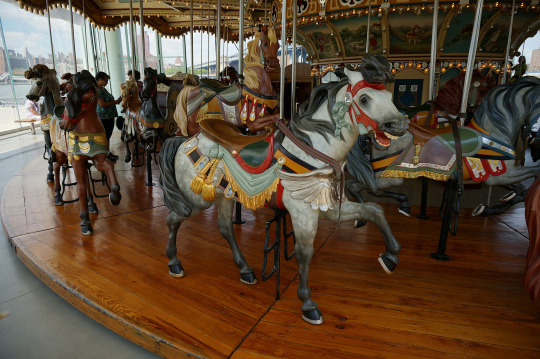#ArtsBizInc: Float Explores Jane’s Carousel in Brooklyn
This year we are highlighting the organizations in NYFA’s Arts Business Incubator (ABI) program through guest posts, featured interviews, and expanded content and sharing their stories on social media under the hashtag #ArtsBizInc. Here is a story from Float, an app and website presenting a collection of stories on New York City’s public art, architecture and history, about Jane’s Carousel in Brooklyn.
If ever strolling the sunny lawns of the Empire Fulton Ferry section of the Brooklyn Bridge Park, be sure to take a ride on one of the 48 horses of this restored vintage carousel. Tickets are only $2 and it’s definitely worth it. The vibrant horses and chariots were first installed in Youngstown, Ohio’s Idora Park in 1922. Idora Park thrived in the golden age of amusement parks during the early to mid twentieth century. By the time a devastating fire took many of the amusements in the spring of 1984, the park was already on the decline. The carousel, named to the National Register of Historical Places in 1975, was scorched and like many of the salvageable amusements, was sold at auction by Norton Auctioneers of Coldwater Michigan. It was at this auction that The Walentas family of Brooklyn came to own the deteriorating carousel for $385,000.
Husband and wife David and Jane Walentas were on a mission to develop the area of the present day Brooklyn Bridge Park. The abandoned space was to be a marina and shopping center with a vintage carousel. David had already contributed to the building up of much of the Dumbo neighborhood, but because of opposition, his plans for the shopping center were replaced by plans for a public park.
Jane Walentas was once an art director at Estee Lauder and chose the Idora carousel because of its beautiful original carving. Though she had hired experts to restore the carousel, notably a Mercedes-Benz car detailer to complete the delicate freehand painting, Jane did much of the hard and difficult tasks herself. For years, she and a part time assistant meticulously scraped off 62 years of dirt and paint to reveal the carousel’s original palette. Once the original paint layer was revealed, Jane recorded the colors and matched them with old photographs of the carousel, which would help in restoring the horses. The horses were repainted, gilded with real gold leaf, and missing embellishments, like glass eyes for the horses, were replaced. The mechanical system was upgraded and the carousel was totally rewired to burn 1,200 bright lights. At night, when the carousel closes, the shadows of the horses are projected onto the pavilion, giving off an enchanting show.
The Walentases, who had left behind the wooden building that originally housed the carousel, hired Pritzker Prize winning French architect, Jean Nouvel, to build a $9 million acrylic encasement for the newly restored carousel. Nouvel referred to the carousel as a “jewel” in the middle of a giant square jewel box. The housing gives riders a 360 degree unobstructed view of the bridges and the East River. After years of restoration, Jane’s Carousel, a labor of love with its brilliant colors and nostalgia, opened to the public on September 16, 2011 for a new generation to enjoy and treasure. In 2012, Hurricane Sandy’s storm surge flooded the carousel with at least 18 inches of water. Though the storm spared the horses, it caused $300,000 worth of damage to the carousel’s electrical systems. One year later, to prevent future damage, it was fitted with floodgates in order to preserve Jane’s Carousel for years to come.
— Story by Meagan Gandolfo, Float Contributor
Float is a collection of stories that will immerse you in New York City’s public art, architecture and history. You can download the iPhone app here. Float is also accepting content contributors at this time and you can apply here.
The organization is part of NYFA’s Arts Business Incubator (ABI) Program, which will see the inaugural cohort of seven participating businesses undergo rigorous training in the essentials of starting and running an arts-based enterprise. Find out more about the businesses and ABI program by clicking here.
You can follow ABI Program’s activities on social media by using the hashtag #ArtsBizInc.
Image credit: Kristina D.C. Hoeppner





